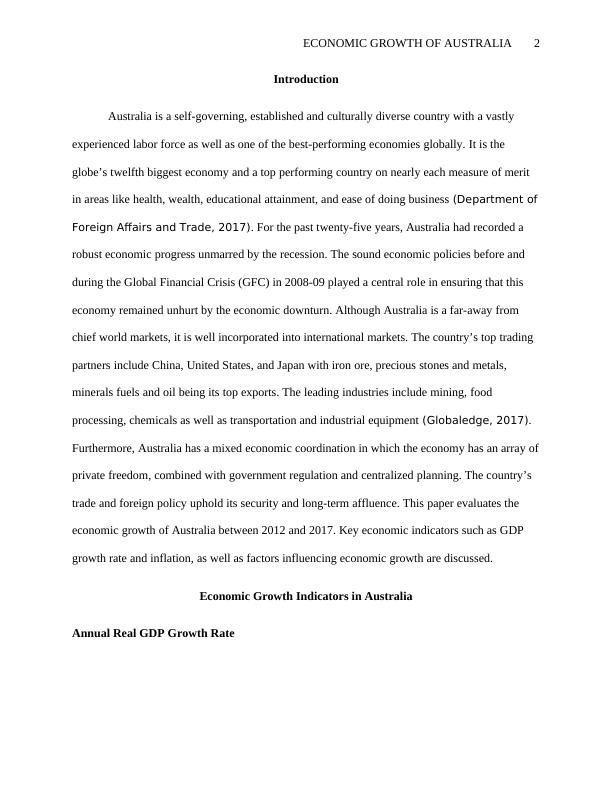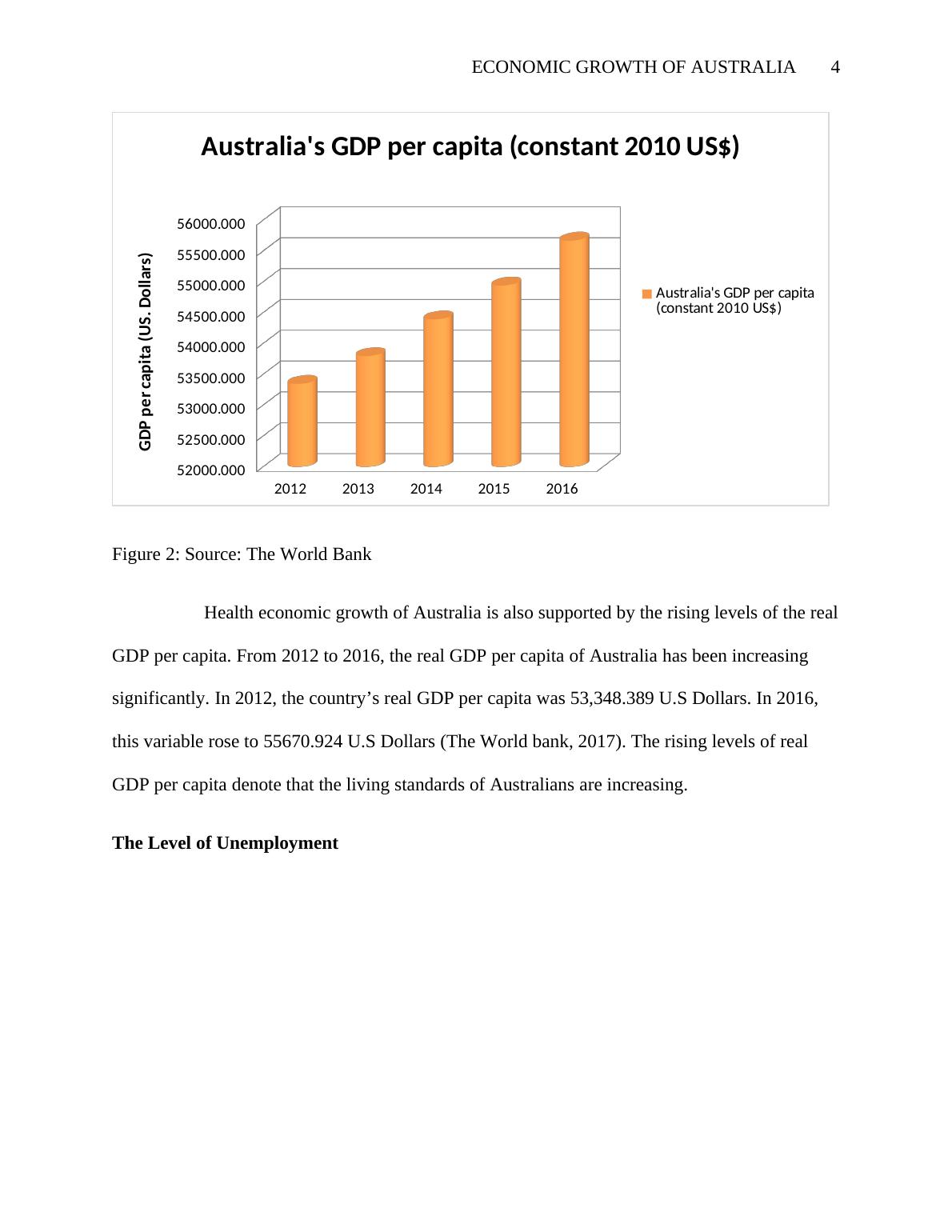The Economic Growth of Australia
Added on 2020-03-28
20 Pages3835 Words46 Views
ECONOMIC GROWTH OF AUSTRALIA 1
ECONOMIC GROWTH OF AUSTRALIA
By (Name)
Name of the class (course)
The Course instructor (Professor)
The Institution
The City and State location
The Date
ECONOMIC GROWTH OF AUSTRALIA
By (Name)
Name of the class (course)
The Course instructor (Professor)
The Institution
The City and State location
The Date

ECONOMIC GROWTH OF AUSTRALIA 2
Introduction
Australia is a self-governing, established and culturally diverse country with a vastly
experienced labor force as well as one of the best-performing economies globally. It is the
globe’s twelfth biggest economy and a top performing country on nearly each measure of merit
in areas like health, wealth, educational attainment, and ease of doing business (Department of
Foreign Affairs and Trade, 2017). For the past twenty-five years, Australia had recorded a
robust economic progress unmarred by the recession. The sound economic policies before and
during the Global Financial Crisis (GFC) in 2008-09 played a central role in ensuring that this
economy remained unhurt by the economic downturn. Although Australia is a far-away from
chief world markets, it is well incorporated into international markets. The country’s top trading
partners include China, United States, and Japan with iron ore, precious stones and metals,
minerals fuels and oil being its top exports. The leading industries include mining, food
processing, chemicals as well as transportation and industrial equipment (Globaledge, 2017).
Furthermore, Australia has a mixed economic coordination in which the economy has an array of
private freedom, combined with government regulation and centralized planning. The country’s
trade and foreign policy uphold its security and long-term affluence. This paper evaluates the
economic growth of Australia between 2012 and 2017. Key economic indicators such as GDP
growth rate and inflation, as well as factors influencing economic growth are discussed.
Economic Growth Indicators in Australia
Annual Real GDP Growth Rate
Introduction
Australia is a self-governing, established and culturally diverse country with a vastly
experienced labor force as well as one of the best-performing economies globally. It is the
globe’s twelfth biggest economy and a top performing country on nearly each measure of merit
in areas like health, wealth, educational attainment, and ease of doing business (Department of
Foreign Affairs and Trade, 2017). For the past twenty-five years, Australia had recorded a
robust economic progress unmarred by the recession. The sound economic policies before and
during the Global Financial Crisis (GFC) in 2008-09 played a central role in ensuring that this
economy remained unhurt by the economic downturn. Although Australia is a far-away from
chief world markets, it is well incorporated into international markets. The country’s top trading
partners include China, United States, and Japan with iron ore, precious stones and metals,
minerals fuels and oil being its top exports. The leading industries include mining, food
processing, chemicals as well as transportation and industrial equipment (Globaledge, 2017).
Furthermore, Australia has a mixed economic coordination in which the economy has an array of
private freedom, combined with government regulation and centralized planning. The country’s
trade and foreign policy uphold its security and long-term affluence. This paper evaluates the
economic growth of Australia between 2012 and 2017. Key economic indicators such as GDP
growth rate and inflation, as well as factors influencing economic growth are discussed.
Economic Growth Indicators in Australia
Annual Real GDP Growth Rate

ECONOMIC GROWTH OF AUSTRALIA 3
2012 2013 2014 2015 2016
0
0.5
1
1.5
2
2.5
3
3.5
4 3.63
2.57 2.61 2.42
2.77
Real GDP growth rate
Real GDP growth rate
%
Figure 1: Source: The World Bank
The data from graph one above shows that for the past five years, Australia has recorded
a robust economic growth. The economic expansion has been above 2 percent, and thus this
economy can be categorized under the expansion phase of the business cycle. Such a remarkable
economic growth is an indication that the government of Australia has put in place sound
economic policies and structures that are favorable for the thriving of the economy.
Real GDP Per Capita
2012 2013 2014 2015 2016
0
0.5
1
1.5
2
2.5
3
3.5
4 3.63
2.57 2.61 2.42
2.77
Real GDP growth rate
Real GDP growth rate
%
Figure 1: Source: The World Bank
The data from graph one above shows that for the past five years, Australia has recorded
a robust economic growth. The economic expansion has been above 2 percent, and thus this
economy can be categorized under the expansion phase of the business cycle. Such a remarkable
economic growth is an indication that the government of Australia has put in place sound
economic policies and structures that are favorable for the thriving of the economy.
Real GDP Per Capita

ECONOMIC GROWTH OF AUSTRALIA 4
2012 2013 2014 2015 2016
52000.000
52500.000
53000.000
53500.000
54000.000
54500.000
55000.000
55500.000
56000.000
Australia's GDP per capita (constant 2010
US$)
Australia's GDP per capita
(constant 2010 US$)
GDP per capita (US. Dollars)
Figure 2: Source: The World Bank
Health economic growth of Australia is also supported by the rising levels of the real
GDP per capita. From 2012 to 2016, the real GDP per capita of Australia has been increasing
significantly. In 2012, the country’s real GDP per capita was 53,348.389 U.S Dollars. In 2016,
this variable rose to 55670.924 U.S Dollars (The World bank, 2017). The rising levels of real
GDP per capita denote that the living standards of Australians are increasing.
The Level of Unemployment
2012 2013 2014 2015 2016
52000.000
52500.000
53000.000
53500.000
54000.000
54500.000
55000.000
55500.000
56000.000
Australia's GDP per capita (constant 2010
US$)
Australia's GDP per capita
(constant 2010 US$)
GDP per capita (US. Dollars)
Figure 2: Source: The World Bank
Health economic growth of Australia is also supported by the rising levels of the real
GDP per capita. From 2012 to 2016, the real GDP per capita of Australia has been increasing
significantly. In 2012, the country’s real GDP per capita was 53,348.389 U.S Dollars. In 2016,
this variable rose to 55670.924 U.S Dollars (The World bank, 2017). The rising levels of real
GDP per capita denote that the living standards of Australians are increasing.
The Level of Unemployment

End of preview
Want to access all the pages? Upload your documents or become a member.
Related Documents
International Trade Economics Assignmentlg...
|12
|2140
|249
Economic Analysis of Chinalg...
|10
|2839
|145
Study of Australian Economy in Global Economic Scenariolg...
|15
|3520
|35
Economy of Australia: Analysis of Macroeconomic Indicators and Future Issueslg...
|13
|2454
|444
ECON1005 - Assignment On The Australian Economylg...
|13
|2713
|38
PRINCIPLE OF MACROECONOMICS QUESTION ANSWER 2022lg...
|5
|759
|33
